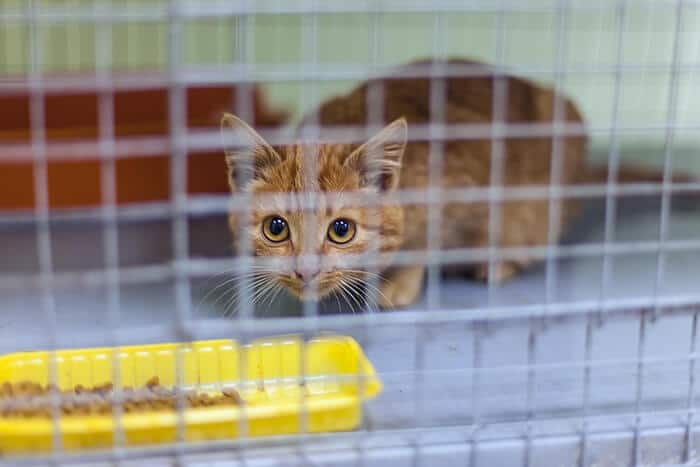The realization that a beloved cat is lost can make any pet owner panic. Maybe your indoor-outdoor cat failed to come in for the night or your indoor-only cat managed to sneak out the front door.
Do not despair. Whether your cat has been missing for just hours or has been gone for days or even weeks, it’s possible to find her.
A few organizations have made it their mission to keep pets and families together. This article will share tips from some of my favorites, including Mission Reunite, a nonprofit organization dedicated to helping to reunite lost pets with their loving families, Best Friends Animal Society and the American Society for the Prevention to Cruelty to Animals.
Look For Clues: Cat Behavior
First, let’s explore some facts about typical cat behavior that may lead you in the right direction, and then we’ll go over some tried-and-true lost-pet tactics to help you find your cat and bring her home.
According to Mission Reunite, when indoor cats escape your home and become lost, they usually stay close to home.
In fact, most lost indoor cats are eventually found hiding or trapped in their own homes or property, or in the homes or property of very close neighbor’s homes. But how can cats be lost at home? And couldn’t you simply call your cat’s name and wait for her to come out of her hiding place or meow?
If you think about cat behavior, it makes sense. Pet cats, especially indoor-only cats, tend to be fearful when outside. Rather than wander, cats often hide and stay put when they become lost.
And unlike lost dogs, lost cats always don’t come when you call them—especially if they are scared. Food might not even tempt a very fearful cat. If you can’t find your cat, it’s possible that she’s hiding somewhere close by.
Mission Reunite says cats have been known to stay in one place hiding without food and water for days and even weeks before being found. Of course, it’s better to find your cat more quickly. Going a long time without food and water can lead to dire consequences for a lost cat.
Cats that are used to going outdoors also tend to stick close to home, though they might be found a bit farther away. When indoor-outdoor cats become lost, they might be hiding in a neighbor’s yard at the end of your street or even a few blocks away.
When indoor-outdoor cats fail to return home, it may be because they have become injured or trapped. The cat may be wedged in somewhere, closed into a shed or garage, or even hunted or chased by other cats, animal predators, or people.
Tips To Help You Find a Lost Cat
According to one study, which looked at the cases of more than 1,200 missing cats, 75% were found within 1/3 mile from the place they disappeared. If your cat goes missing, the first thing to do is conduct a thorough search of your home and surrounding areas. If you still can’t find your cat, things are not hopeless. There are many more steps you can take to bring kitty safely home. Consider the following tips:
1. Conduct a Physical Search Inside Your Home.
Cats may become trapped in attics or basements, accidentally closed into an unused room, or may hide in closets or under beds. Search high and low, opening doors, peering under furniture, and investigating boxes and other containers. Check inside cupboards and hinged toy boxes and storage ottomans. Don’t forget to check behind your appliances and to look in even the smallest of spaces. Cats are surprisingly flexible and can squeeze themselves into very small places. Pause occasionally to listen for meowing.
2. Conduct a Physical Search Outside Your Home.
After you’ve scoured the house or if your cat lives outdoors at least some of the time, search your yard.
Some common cat hiding places outdoors include inside sheds, under decks or patios, beneath your porch or the crawl space under your home, and in bushes, trees or shrubbery. Don’t forget to check inside your garage and under your car. Enlist gentle neighborhood kids to help you look—they might think to look in places you wouldn’t.
3. Search the Homes and Yards of Your Neighbors.
Your cat might be “lost” in the yard next door. Ask your neighbors if they have seen a cat, and inquire if you might search on their property. Text or email your neighbors and ask them to keep an eye out for your cat. Post on your social media pages as well as local social media pages so people know to be on the lookout.
4. Check Local Animal Shelters and Call Veterinary Hospitals.
Your cat may have been picked up and brought to your local animal shelter. Although you can call the shelter or animal control to inquire if a cat fitting your cat’s description has been turned in, it’s best to visit daily so you can see for yourself.
If your cat is injured or ill, a good Samaritan may have dropped her off at a veterinary hospital. Call around to the veterinarians in your local area to inquire.
5. Put Up “Lost Cat” Signs.
If you have searched every inch of your home and yard, and the yards of close neighbors, with no sign of your cat, and if your cat hasn’t turned up at your local shelter, you can take further steps to bring kitty home.
It’s possible that someone in your neighborhood may have seen your cat or even taken her inside thinking she was a stray. Consider hanging “lost cat” posters and signs in your neighborhood, and handing out or posting “lost cat” fliers.
All too often “lost pet” posters are too small and hard to read. You want to catch someone’s attention who might not be earnestly looking to read a poster or sign.
Mission Reunite offers some helpful tips for effective lost pet posters. The group recommends an approach they call 5+5+55, which, in a nutshell, means keep your poster to five words that can be read in five seconds by someone driving 55 miles per hour.
Rather than plain white paper, use brightly colored paper or poster board (try neon colors). Write in huge letters that can be seen from very far away, and include a large color photo of your cat if possible. Hang posters close within about ½ mile from your home and post fliers in local veterinary clinics, pet stores, coffee shops, grocery stores, and community centers.
6. Try a Remote Camera or Humane Trap.
Using a humane trap, like those implemented in TNR (trap, neuter, return) efforts, can help you to capture your lost cat.
Some lost cats are nearby but remain in their hiding place, too scared to come out during daylight. They might come out to eat and drink when the feel the coast is clear. For very shy and fearful cats, try setting out some cat food and water and a motion-activated security camera or even a video baby monitor.
If your cat comes out at some point, you may be able to deduce where she’s been hiding. You can also try a humane wildlife trap in combination with a motion-sensing camera. Check with your local animal shelter or cat rescue, which might have such a trap on hand for capturing feral cats for TNR programs.
7. Hire a Pet Detective.
If all your efforts haven’t turned up your cat, you might consider hiring a pet detective. Pet detectives are trained to find missing animals, sometimes using Bloodhounds or other dogs to sniff out a lost pet. When hiring a pet detective, do your homework and ask for references to be sure the person is reputable and experienced.
The Missing Animal Response Network, which is operated by Kat Albrecht, a former police bloodhound handler, crime scene investigator, search-and-rescue manager, and police-officer-turned-investigative pet detective, offers missing pet recovery training.
For the Future: Prevent Your Cat From Getting Lost
Once your kitty is back home safe and sound, you can take some steps to make sure she never goes missing again. Consider the following tips:
1. Collar and Tag
All cats, even indoor-only cats, should wear a collar and identification tag that has your name and phone number. Make sure your contact information is up to date. If you change your telephone number, get a new ID tag engraved.
2. Microchip
Lost cats that end up in animal shelters and veterinary offices are always scanned for a microchip. If your cat doesn’t already have a microchip, ask your vet to place one during her next visit. If your cat already has a microchip, make sure it’s registered and your information is up to date.
3. Pet Activity Collar With GPS Tracking
Tractive 3G GPS Pet Tracker
A small, lightweight device worn on the collar, pet activity trackers can tell you how much exercise your cat is getting and other helpful information. Some pet activity trackers come with GPS, which allow you to pinpoint where your cat is if she becomes lost.
Read More: Top 8 Best Cat Trackers
Frequently Asked Questions
What are the chances of finding a lost cat?
According to a study of missing cats published in 2018 the journal Animals, 61 percent of cats were found within one year, with 34% recovered alive within seven days. Of these, 59% were found because the cat owners actively searched for them.
Can cats find their way home if lost?
Cats may not find their own way home if they are injured, trapped or fearful. Actively searching for your cat in and around your home, property and neighborhood is the best way to recover your lost cat.
How do you attract a cat back home?
If you suspect your cat may be hiding somewhere nearby, you can put food and water out to try to lure her back home. Also consider using a motion-sensor camera or humane wildlife trap.
How long should my cat be missing before I worry?
Worrying and anxiety never help when finding a lost cat, but acting quickly will significantly increase your chances of being reunited. Start looking for your cat as soon as you notice that they've been away for longer than usual. This varies from cat to cat. For some cats, a few hours' absence is cause for concern, while others—especially outdoor cats—may go wandering all night. In general, a cat who doesn't come out—or come home—for mealtime justifies a search. If your cat has been missing for 12 hours or more and you haven't already started looking, it's time to start your search in earnest, following the steps outlined in this article.












Thanks for the great post!! I just subscribed to the newsletter as well. Just wanted to add that after 33 days of our indoor cat being lost in La Mesa, CA (just outside San Diego) our cat Ginny came home and went into our Havahart Trap we had our consistently for most nights while she was gone. So they work! 🙂
So happy that you and Ginny were reunited!
My Tallulah was either lost or stolen in October when I was in the hospital.I was in the hospital for 6 weeks. I hired a pet detective and she was completely worthless. Money down the drain. I have reason to believe that the person that was feeding her stole her. I am broken hearted and I don’t think I’ll ever get over it. Nothing like this has ever happened to me. It has made it more difficult for physical healing because I’m so sad about her. After all this time, I guess I won’t ever find her. Be careful who you hire to feed your pets if you have to be away from home. Even if they have an employer that’s very nice and honest, that person may not be.
I’m very sorry to hear what happened; losing a cat, whether they were stolen or not, is a traumatic experience, and I can only imagine that it was compounded by the fact that you were also unwell at the time. Thinking that your cat’s caregiver may have stolen her must shake your trust in people, too. Is there any way you could start an (informal) investigation into the person who was supposed to care for your cat? I think knowing whether or not they took your cat would put your mind at ease significantly. Wishing you and Tallulah all the best.
I see that you wouldn’t post my comment. Why not? I was speaking about what happened to me. Seems like you don’t care. You must only want comments that state that people find their cats. It doesn’t always happen. Shame on you for deleting my post.
Brenda, I apologize! Actually, all posts go through a moderation stage after they’re submitted, and I have to go through and approve them before they go live. I hadn’t yet gotten to your comment today. It’s now approved and live on the page.
My girl snuck out the door when no one was looking, she was gone for hrs. before we noticed. I went out in my backyard shaking a bag of her favourite treats and she still didn’t come. I never gave up looking for her. Finally I went to the spot where she was born and there she was hiding behind some bord’s. She still didn’t come when I showed her the treats, she cowered. I just picked her up and brought her back inside and gave her her treat.
So glad to hear you found your cat, Karen! Thanks for sharing
BEST INFO EVER!!!!!!!!